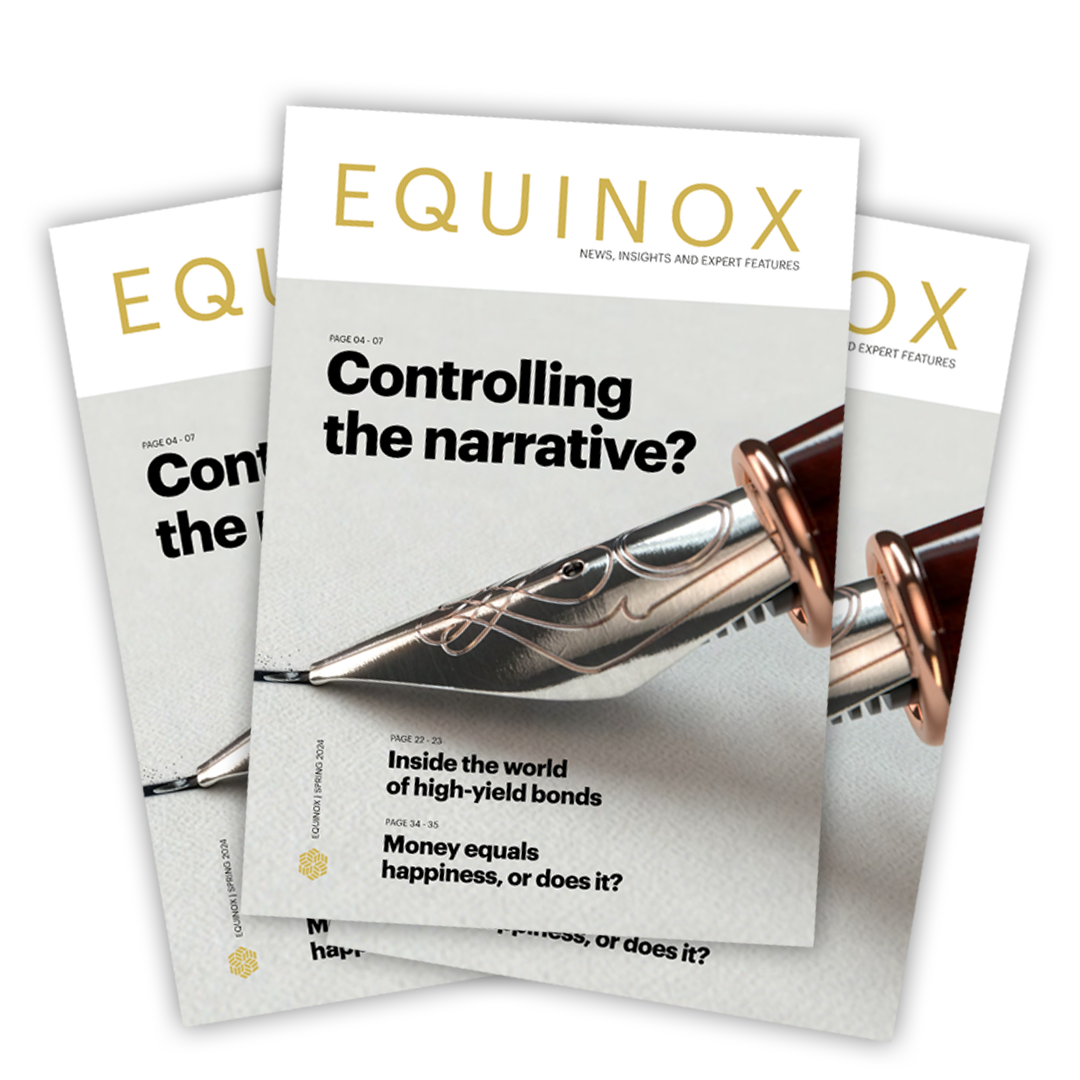Out of the woodwork
This month’s The Pulse was initially drafted on Wednesday 8 March.
On Thursday 9 March, Venture Capitalist Peter Thiel (Co-Founder of PayPal amongst other firms) advised the firms he worked with to take their money out of Silicon Valley Bank (SVB) – the 18th largest bank in the US that specialises in providing banking services to technology firms.
By Friday 10 March, this had turned into a fully-fledged bank run and much of what I had written on the Wednesday was now well out of date!
This is a great illustration of how things can come out of the woodwork and quickly change in the world of finance. We’ve decided to keep much of the original text below as the context is still relevant. However, our conclusions for the economic and market outlook may be slightly different depending on how things evolve with SVB.
Here is a short summary of what we know about SVB and our initial thoughts on how this may change things:
- The reason that SVB ran into trouble was not because of losses on bad debts – the usual cause of concerns about banks.
- Like all banks, SVB has assets (loans, capital) and liabilities (mainly deposits). Unusually, a high proportion of SVB’s assets were held in long-dated government bonds.
- Such bonds saw big losses last year as interest rates went up. If held to maturity, this isn’t an issue, however, if SVB have to sell, they will realise some hefty losses.
- As a result, SVB decided that they wanted to raise equity capital to shore up their balance sheet.
- This may have been a mistake since it essentially flagged up the potential issue! Technology firms began taking their money out of the bank and the equity issue failed.
- No bank can withstand a bank run of this nature, and so whilst they may have been a perfectly viable business beforehand, the concerns became something of a “self-fulfilling prophecy.”
- The US authorities have now stepped in to protect depositors in the States (there will be no protection for bond and equity investors), and HSBC has bought their UK assets.
- Meanwhile, equity markets have dropped sharply, driven by falling bank shares.
This is an evolving story and it’s difficult to say how it may play out. However, here are a few possible outcomes:
- On the one hand, SVB’s issues look fairly specific to them and most other banks don’t have the same exposure to long-dated bonds and therefore shouldn’t have the same issues.
- However, once a bank run starts, the rational thing for a depositor to do is join the queue of people taking their money out.
- Another rational thing to do might be to remove your deposits from any other bank you think could have similar issues – including smaller banks – just in case. This is why bank shares are falling.
- Whilst a few days ago, the market was expecting the Fed to put up rates by another 0.5% this month, they may now do a smaller hike or no hike at all.
- This issue has essentially been caused by the rapid rise in interest rates, which is why bonds have gone down, so it may be dangerous for the Fed to do further interest rate hikes until the situation becomes clearer.
- Government bonds have rallied in expectation of lower rates (or fewer increases).
- Whilst unlikely, it is possible that there is a knock-on effect not just to other banks, but to companies who perhaps can’t access some of their capital held with those banks.
- As a result, we can’t rule out this being the catalyst for an economic downturn.
- However, more likely in our view, this may all be contained, the authorities can reassure depositors and shore up the banking system.
- SVB might therefore turn out to be a very specific and one-off issue, and we may go back to the way we were.
- It is important to remember that European and UK banks are subject to much tighter regulations and are much less likely to encounter the sort of issues currently being experienced by small US banks.
- Meanwhile, larger US banks are seeing big inflows in deposits as people move their money to more secure institutions.
This is a fast-evolving situation, and we will of course be watching carefully. We will be double-checking, but as far as we can tell, the Equilibrium funds had almost no exposure to SVB (it is not held in our actively managed funds but there is a 0.02% holding in an index-tracking fund).
The below is how we saw things before the SVB issues came to light…
Goldilocks Part II
In last month’s The Pulse, we talked about the “Goldilocks zone” for investments.
Investors want to see economic data, which is not too hot, not too cold, but just right.
If the economy is doing badly then that’s not great for company earnings and therefore share prices. On the flip side, if the economy is running hot, especially if inflation proves “sticky,” then central banks are likely to hike interest rates more aggressively.
Higher rates are not great for government bonds or for many types of stock, particularly technology stocks or highly leveraged companies. Higher rates also increase the chance of an economic downturn further down the line.
In the last month, the economic data has definitely veered more towards the “too hot” end of the spectrum, which led stocks and bonds to go down slightly during February.
Sticky stuff
For much of 2022, economies around the world were showing signs of a slowdown, with many people expecting a recession in the early part of 2023.
However, since the beginning of this year, business surveys indicate that many economies have, in fact, started to re-accelerate. Consumer spending has held up well, and, in particular, people are spending their money on services rather than goods, in a reversal of the pandemic trend.
A growing economy is good news but brings with it renewed concerns about inflation. Goods and energy prices are generally falling, which could bring down the headline inflation figures pretty rapidly.
However, we are seeing more evidence of service inflation, which tends to be “stickier.” Whereas commodity and goods prices can be volatile and go down as well as up, once prices of services increase, they are more likely to stay there.
As a result, it is possible that central banks will put up interest rates even higher and keep them there longer. In the US, investors think the central bank, the Federal Reserve, will raise them to 5.5% and there’s even an outside chance they go to 6%. (Source: Refinitiv Eikon / Equilibrium Investment Management)
In the UK, the base rate is currently 4% and markets are pricing them to go to 4.5% in the near future. (Source: Refinitiv Eikon / Equilibrium Investment Management)
In portfolios, we reduced our government bond exposure in response to this new data.
We sold most of our gilt exposure when the yield on the 10-year bond fell as low as 3%, having been above 4% after last September’s Mini Budget. The yield has subsequently gone up (meaning the price has gone down).
We have also sold some of our US Treasury holdings (American government bonds) and instead switched into a US dollar cash fund. The US 10-year bond yielded around 3.7% at the time of sale, whereas we get 4.4% on our dollar cash at present and expect this to increase to closer to 5% in the near future.
Corporates are different
In previous editions of The Pulse, I’ve explained why we are enthusiastic about corporate bonds at the moment, despite the possibility of rates moving higher.
The current interest rate hiking cycle is the fastest in history. At the beginning of 2022, both the UK and US central banks had rates at 0.5%.
Now, the Bank of England base rate is 4% – an increase of 3.5% over this period – while US rates are 4.75%, an increase of 4.25%, or over 7 times higher than the level at the start of last year! (Source: Refinitiv Eikon / Equilibrium Investment Management)
As a result of these rate hikes, during 2022 the average sterling corporate bond fund lost 16.6% (Source: Financial Express 01/01/22 – 21/12/22). Naturally, investors might worry that this could be repeated, however, we think this is very unlikely.
We are starting from a very different place in terms of interest rates. Whilst they will probably go up further, we think it is very unlikely that the same pace of increase can be repeated. If it were, we would see rates at 7.5% and 9% respectively.
We are also starting from a different place in terms of the yields on bonds. At the start of 2022, the investment grade corporate bond index yielded around 2% p.a. Now the yield is close to 6%. (Source: Refinitiv Datastream)
When a bond yields 2%, an interest rate increase of 1% is very significant, since it is equivalent to half the yield.
However, at current levels, a 1% move in rates would only be equivalent to around 1/6 of the yield, so the price would not react as sharply.
In summary, interest rates are very unlikely to move as much as last year and each percentage point move should also have less effect on the returns from bonds. We, therefore, feel interest rate risk is now relatively low in this asset class.
High yield = high risk?
What I have described above applies to investment-grade bonds, which are those issued by relatively secure companies.
We also invest in “high-yield” corporate bonds; those where the companies have a lower credit rating.
Remember, a corporate bond is effectively a loan to a company. The company will pay us interest and will repay our loan at the end of the term. But if the company goes bankrupt, then the interest and capital are both at risk.
At present, we have two dedicated “high-yield” funds in the portfolio, which currently pay an average yield of around 9.8% p.a. (Source: the fund managers). Given the size of the yield, we think the likely increase in interest rates should have a fairly negligible effect on these bonds.
The risk to high yield in our view is not that the economy runs too hot (to return to our Goldilocks theme) and that interest rates go up, but that the data comes in too cold, that companies go bankrupt and we lose some or all our capital.
However, we think the income we are getting paid more than compensates us for that risk, even if the economy goes into a deep recession.
For ease of maths, let’s assume we are getting a yield of 10% per year for our portfolio of high-yield bonds.
Now let us assume 10% of those companies go bankrupt in the first year, and we lose 100% of the money we’ve lent to those companies. We, therefore, make a capital loss of 10%.
However, imagine that the remaining 90% of our bonds continue to pay us our 10% p.a. coupon, which means we get an annual income equivalent to 9% of our initial investment.
In this extremely negative scenario, we lose 1% in the first year (9% income received, minus 10% capital loss).
However, we then continue to receive the 9% income in the next year, so by the end of year two, we’ve made a total return of +8% (assuming no further defaults).
We think a scenario as negative as this is highly unlikely. In the financial crisis (the worst period we can find), the default rate on European high-yield bonds reached 10% and it was closer to 16% in the US (Source: Deutsche Bank).
Importantly, a corporate default does not usually mean you lose 100% of your money. Creditors of companies who go bankrupt can usually recover some of their money once assets have been sold. Over the last 25 years, the average recovery rate on a high-yield default has been 40% (Source: DWS Research Institute).
Therefore, in the (in our view highly unlikely) scenario that 10% of our bonds suffered a default, we might perhaps lose 6% capital (10% initial loss plus the 4% recovered from the liquidators). Applying this to the above scenario, with 9% p.a. income from the remaining bonds, we might therefore make a 3% gain over 12 months.
Of course, these are simplified examples and we can’t predict what will happen in the future, but looking at past history gives us a lot of comfort. It also ignores the “mark-to- market” effect, where the price of other bonds might be temporarily marked down due to sentiment.
Ta-ra equities?
We think the risk/reward ratio on selected high-yield bonds look very attractive. So, how does this compare to equities?
For equities to produce a return, we need to see evidence of growth (whether now or in the future). However, for a corporate bond, we just need the company to not go bankrupt.
As outlined earlier, the outlook for equities is uncertain with the competing dynamics of economic growth and interest rates having a big effect. We think there are a few areas where equities look great value, but also some areas where they look quite expensive.
For some years we have talked about the dynamics of TINA, where “there is no alternative” to investing in equities since the returns on cash and bonds looked so poor.
That has all changed as interest rates have gone up. There are a few new acronyms, such as TIARA (this is a reasonable alternative), TAPAS (there are plenty alternatives – which doesn’t really work in our view) or, our favourite, TARA (there are reasonable alternatives). You can read this as a woman’s name, or in a Northern accent, it sounds like someone saying goodbye!
So, is it time to say “ta-ra” to equities?
Well, we wouldn’t go that far, but when we plug the expected returns and risks of various asset classes into our asset allocation tools, we are currently getting some interesting results.
In essence, our spreadsheets say we should consider reducing equities fairly significantly and increase high yield instead.
With high yield, we need to be very selective over which fund managers and bonds we hold, given the inherent risks. We might also be wrong and equities could absolutely fly given the right set of circumstances.
However, we are looking at this closely and have already begun something of a transition to this effect.
We have just had another defined returns product kick out, the third since December. Rather than reinvest the kick-out proceeds back into defined returns or equities, in most portfolios, we have instead been topping up corporate bonds. We are likely to make further moves in this direction.
In summary, we think it would be difficult for the economy to remain in the Goldilocks zone indefinitely, but we believe selected corporate bonds look a good way of navigating some of this uncertainty.
Past performance is for illustrative purposes only and cannot be guaranteed to apply in the future.
This blog is intended as an information piece and does not constitute a solicitation of investment advice.
If you have any further questions, please don’t hesitate to contact us. If you’re a client you can reach us on 0161 486 2250 or by getting in touch with your usual Equilibrium contact. For all new enquiries please call 0161 383 3335.



